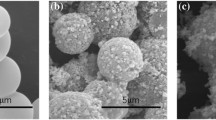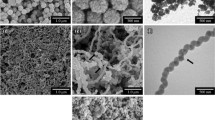Abstract
Reasonable design of composition and microstructure of carbon nanomaterials can significantly enhance their electromagnetic energy conversion, which provides new strategies for expanding their application in the field of microwave absorption. In this study, core–shell nanowires, silver nanowires (AgNW) wrapped by polypyrrole-derived carbon shells (PPyC), have been successfully acquired through in situ polymerization of pyrrole monomers on the surface of AgNW and following carbonization in vacuum atmosphere. Composition, microstructure and microwave absorption properties of the produced hybrid nanowires are characterized by scanning electron microscope, transmission electron microscope, Fourier transform infrared spectroscopy, X-ray diffraction, Raman spectroscopy and vector network analyzer, respectively. The heterostructured AgNW@PPyC nanowires present increased electrical conductivity and high aspect ratio due to the incorporation of AgNW, which activates multiple loss mechanisms including interfacial polarization, dipole polarization and related relaxation to achieve desirable microwave absorption performance. The AgNW@PPyC nanowires exhibited a minimum reflection loss value of −38.60 dB at the frequency of 10.30 GHz with the thickness of 2.57 mm and an effective absorption bandwidth of 3.53 GHz in the X-band (85%). The core–shell AgNW@PPyC nanowires with tunable composition and unique nanostructure are promising for realizing highly-efficient microwave absorption performance of carbon materials.
Graphical abstract
Homogeneous core–shell AgNW@pyrolytic carbon composites were successfully fabricated through in situ polymerization of pyrrole monomers on the surface of AgNW and subsequent vacuum carbonization. The AgNW@PPyC nanowires exhibited a minimum reflection loss value of −38.60 dB at the frequency of 10.30 GHz with the thickness of 2.57 mm and an effective absorption bandwidth of 3.53 GHz in the X-band.









Similar content being viewed by others
References
Yang M, Yuan Y, Yin W et al (2019) Co/CoO@C nanocomposites with a hierarchical bowknot-like nanostructure for high performance broadband electromagnetic wave absorption. Appl Surf Sci 469:607–616. https://doi.org/10.1016/j.apsusc.2018.10.045
Xie A, Zhang K, Sun M et al (2018) Facile growth of coaxial Ag@polypyrrole nanowires for highly tunable electromagnetic waves absorption. Mater Des 154:192–202. https://doi.org/10.1016/j.matdes.2018.05.039
Liu X, Cui X, Chen Y et al (2015) Modulation of electromagnetic wave absorption by carbon shell thickness in carbon encapsulated magnetite nanospindles-poly(vinylidene fluoride) composites. Carbon 95:870–878. https://doi.org/10.1016/j.carbon.2015.09.036
Sun Y, Wang N, Yu H et al (2020) Metal-organic framework-based Fe/C@Co3O4 core-shell nanocomposites with outstanding microwave absorption properties in low frequencies. J Mater Sci 55:7304–7320. https://doi.org/10.1007/s10853-020-04521-w
Guo Y, Wang D, Bai T et al (2021) Electrostatic self-assembled NiFe2O4/Ti3C2Tx MXene nanocomposites for efficient electromagnetic wave absorption at ultralow loading level. Adv Compos Hybrid Mater 4:602–613. https://doi.org/10.1007/s42114-021-00279-0
Yang S, Sun X, Ning Y et al (2022) Effectively tuning electromagnetic absorption of carbon-based nanocomposites by phase transition. Carbon 190:47–56. https://doi.org/10.1016/j.carbon.2021.12.091
Liu Y, Cui T, Li Y et al (2016) Effects of crystal size and sphere diameter on static magnetic and electromagnetic properties of monodisperse Fe3O4 microspheres. Mater Chem Phys 173:152–160. https://doi.org/10.1016/j.matchemphys.2016.01.053
Xie A, Jiang W, Wu F et al (2015) Interfacial synthesis of polypyrrole microparticles for effective dissipation of electromagnetic waves. J Appl Phys 118:204105. https://doi.org/10.1063/1.4936549
Jiang L, Wang Z, Geng D et al (2016) Carbon-encapsulated Fe nanoparticles embedded in organic polypyrrole polymer as a high performance microwave absorber. J Phys Chem C 120:28320–28329. https://doi.org/10.1021/acs.jpcc.6b09445
Kang H, Yeo J, Hwang J et al (2011) Simple ZnO nanowires patterned growth by microcontact printing for high performance field emission device. J Phys Chem C 115:11435. https://doi.org/10.1021/jp2019044
Liu P, Huang Y, Yang Y et al (2016) Sandwich structures of graphene@Fe3O4@PANI decorated with TiO2 nanosheets for enhanced electromagnetic wave absorption properties. J Alloys Compd 662:63–68. https://doi.org/10.1016/j.jallcom.2015.12.022
Ren Y, Zhu C, Zhang S et al (2013) Three-dimensional SiO2@Fe3O4 core/shell nanorod array/graphene architecture: synthesis and electromagnetic absorption properties. Nanoscale 5:12296–12303. https://doi.org/10.1039/c3nr04058e
Wang Q, Lei Z, Chen Y et al (2013) Branched polyaniline/molybdenum oxide organic/inorganic heteronanostructures: synthesis and electromagnetic absorption properties. J Mater Chem A 1:11795. https://doi.org/10.1039/c3ta11591g
Liu X, Li B, Geng D et al (2009) (Fe, Ni)/C nanocapsules for electromagnetic-wave-absorber in the whole Ku-band. Carbon 47:470–474. https://doi.org/10.1016/j.carbon.2008.10.028
Tian C, Du Y, Xu P et al (2015) Constructing uniform core-shell PPy@PANI composites with tunable shell thickness toward enhancement in microwave absorption. ACS Appl Mater Interfaces 7:20090–20099. https://doi.org/10.1021/acsami.5b05259
Li X, Yu L, Zhao W et al (2020) Prism-shaped hollow carbon decorated with polyaniline for microwave absorption. Chem Eng J 379:122393. https://doi.org/10.1016/j.cej.2019.122393
Ding D, Wang Y, Li X et al (2017) Rational design of core-shell Co@C microspheres for high-performance microwave absorption. Carbon 111:722–732. https://doi.org/10.1016/j.carbon.2016.10.059
Du Y, Liu W, Qiang R et al (2014) Shell thickness-dependent microwave absorption of core-shell Fe3O4@C composites. ACS Appl Mater Interfaces 6:12997–13006. https://doi.org/10.1021/am502910d
Liu P, Gao S, Wang Y et al (2020) Core-shell Ni@C encapsulated by N-doped carbon derived from nickel-organic polymer coordination composites with enhanced microwave absorption. Carbon 170:503–516. https://doi.org/10.1016/j.carbon.2020.08.043
Liang C, Wang Z (2017) Controllable fabricating dielectric-dielectric SiC@C core-shell nanowires for high-performance electromagnetic wave attenuation. ACS Appl Mater Interfaces 9:40690–40696. https://doi.org/10.1021/acsami.7b13063
Zhou J, Tao J, Yao Z et al (2021) Ag nanoparticles embedded in multishell carbon nanoparticles for microwave absorption. ACS Appl Nano Mater 4:5425–5436. https://doi.org/10.1021/acsanm.1c00749
Lee H, Hong S, Lee J et al (2016) Highly stretchable and transparent supercapacitor by Ag-Au core-shell nanowire network with high electrochemical stability. ACS Appl Mater Inter 8:15449. https://doi.org/10.1021/acsami.6b04364
Bang J, Coskun S, Pyun K et al (2021) Advances in protective layer-coating on metal nanowires with enhanced stability and their applications. Appl Mater Today 22. https://doi.org/10.1016/j.apmt.2020.100909
Bellew A, Manning H, da Rocha C et al (2015) Resistance of single Ag nanowire junctions and their role in the conductivity of nanowire networks. ACS Nano 9:11422–11429. https://doi.org/10.1021/acsnano.5b05469
De S, Higgins T, Lyons P et al (2009) Silver nanowire networks as flexible, transparent, conducting films: extremely high DC to optical conductivity ratios. ACS Nano 3:1767–1774. https://doi.org/10.1021/nn900348c
Langley D, Giusti G, Mayousse C et al (2013) Flexible transparent conductive materials based on silver nanowire networks: a review. Nanotechnology 24:452001. https://doi.org/10.1088/0957-4484/24/45/452001
Jung J, Lee H, Ha I et al (2017) Highly stretchable and transparent electromagnetic interference shielding film based on silver nanowire percolation network for wearable electronics applications. ACS Appl Mater Inter 9:44609. https://doi.org/10.1021/acsami.7b14626
Zhang N, Huang Y, Wang M et al (2019) Design and microwave absorption properties of thistle-like CoNi enveloped in dielectric Ag decorated graphene composites. J Colloid Interface Sci 534:110–121. https://doi.org/10.1016/j.jcis.2018.09.016
Sun N, Guan Z, Liu Y et al (2019) Extended “adsorption-insertion” model: a new insight into the sodium storage mechanism of hard carbons. Adv Energy Mater 9:1901351. https://doi.org/10.1002/aenm.201901351
Wu Z, Tian K, Huang T et al (2018) Hierarchically porous carbons derived from biomasses with excellent microwave absorption performance. ACS Appl Mater Interfaces 10:11108–11115. https://doi.org/10.1021/acsami.7b17264
Quan L, Qin F, Estevez D et al (2017) Magnetic graphene for microwave absorbing application: towards the lightest graphene-based absorber. Carbon 125:630–639. https://doi.org/10.1016/j.carbon.2017.09.101
Wen B, Yang H, Lin Y et al (2021) Controlling the heterogeneous interfaces of S, Co co-doped porous carbon nanosheets for enhancing the electromagnetic wave absorption. J Colloid Interface Sci 586:208–218. https://doi.org/10.1016/j.jcis.2020.10.085
Phromviyo N, Thongbai P, Ratchaphonsaenwong K et al (2019) Dielectric and electrical properties of nano-Ag/C3AH6 nanocomposites. Appl Surf Sci 483:294–301. https://doi.org/10.1016/j.apsusc.2019.03.293
Sun H, Che R, You X et al (2014) Cross-stacking aligned carbon-nanotube films to tune microwave absorption frequencies and increase absorption intensities. Adv Mater 26:8120–8125. https://doi.org/10.1002/adma.201403735
Naito Y, Suetake K (1971) Application of ferrite to electromagnetic wave absorber and its characteristics. IEEE Trans Microw Theory Tech MT19:65. https://doi.org/10.1109/tmtt.1971.1127446
Song W, Cao M, Fan L et al (2014) Highly ordered porous carbon/wax composites for effective electromagnetic attenuation and shielding. Carbon 77:130–142. https://doi.org/10.1016/j.carbon.2014.05.014
Qiang R, Du Y, Zhao H et al (2015) Metal organic framework-derived Fe/C nanocubes toward efficient microwave absorption. J Mater Chem A 3:13426–13434. https://doi.org/10.1039/c5ta01457c
Yu Y, Wang M, Bai Y et al (2019) Tuning the inner hollow structure of lightweight amorphous carbon for enhanced microwave absorption. Chem Eng J 375. https://doi.org/10.1016/j.cej.2019.121914
Cao M, Song W, Hou Z et al (2010) The effects of temperature and frequency on the dielectric properties, electromagnetic interference shielding and microwave-absorption of short carbon fiber/silica composites. Carbon 48:788–796. https://doi.org/10.1016/j.carbon.2009.10.028
Tan R, Zhou J, Yao Z et al (2021) Ferrero Rocher (R) chocolates-like FeCo/C microspheres with adjustable electromagnetic properties for effective microwave absorption. J Alloys Compd 857:157568. https://doi.org/10.1016/j.jallcom.2020.157568
Chen F, Luo H, Cheng Y et al (2019) Fe/Fe3O4@N-doped carbon hexagonal plates decorated with Ag nanoparticles for microwave absorption. ACS Appl Nano Mater 2:7266–7278. https://doi.org/10.1021/acsanm.9b01755
Liu P, Ng V, Yao Z et al (2017) Facile synthesis and hierarchical assembly of flowerlike NiO structures with enhanced dielectric and microwave absorption properties. ACS Appl Mater Interfaces 9:16404–16416. https://doi.org/10.1021/acsami.7b02597
Chen J, Jia H, Liu Z et al (2020) Construction of C-Si heterojunction interface in SiC whisker/reduced graphene oxide aerogels for improving microwave absorption. Carbon 164:59–68. https://doi.org/10.1016/j.carbon.2020.03.049
Acknowledgements
We thank Mr Junwang Fu (School of Petroleum Engineering, Xi′an Shiyou University, Xi′an 710065, China.) for experimental assistance. This research was supported by the National Natural Science Foundation of China (31800802), Fundamental Research Project of National Defense (2021-JCJQ-ZD-046-00) and Innovation Capability Support Fund of Shaanxi Province (S2021-0-ZC-XXXM-0030).
Author information
Authors and Affiliations
Corresponding author
Ethics declarations
Conflict of interest
The authors declare that they have no conflict of interest.
Additional information
Handling Editor: Gregory Rutledge.
Publisher's Note
Springer Nature remains neutral with regard to jurisdictional claims in published maps and institutional affiliations.
Rights and permissions
Springer Nature or its licensor (e.g. a society or other partner) holds exclusive rights to this article under a publishing agreement with the author(s) or other rightsholder(s); author self-archiving of the accepted manuscript version of this article is solely governed by the terms of such publishing agreement and applicable law.
About this article
Cite this article
Wu, J., Zhao, Y., Zhao, X. et al. Core–shell nanowires comprising silver@polypyrrole-derived pyrolytic carbon for high-efficiency microwave absorption. J Mater Sci 57, 20672–20684 (2022). https://doi.org/10.1007/s10853-022-07947-6
Received:
Accepted:
Published:
Issue Date:
DOI: https://doi.org/10.1007/s10853-022-07947-6




